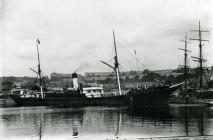Gellir lawrlwytho cynnwys at ddefnydd anfasnachol, megis defnydd personol neu ar gyfer adnoddau addysgol.
Ar gyfer defnydd masnachol cysyllwch yn uniongyrchol gyda deilydd yr hawlfraint os gwelwch yn dda.
Read more about the The Creative Archive Licence.
Disgrifiad
Although the wreck of the FALABA is in Irish Waters, its story became intertwined with that of the AGUILA because the same Uboat was involved – the U28 commanded by Baron von Forstner.
The story of the loss the FALABA reverberated through Welsh and American newspapers bringing the strained diplomatic relationship between Germany and the USA to a new level of tension. Among the people killed was US citizen, Leon Thresher, a mining engineer heading towards the Gold Coast in Africa (now Ghana).
The AGUILA met with its fate on the Saturday night, 27 March 1915, off the Pembrokeshire coast. In this case, the submarine kept up shell-fire while the crew were launching their lifeboats, and several of the crew and one lady passenger were shot. The FALABA which had left the Mersey on the Saturday for West Africa, was torpedoed about midday on Sunday, 28 March 1915, some miles to the west of the Smalls. Warning was given by the Germans for the crew and passengers to take to the boats, but before they could do so a torpedo was fired, and the vessel sank almost immediately.
The FALABA was owned by the Elder Dempster shipping line of Liverpool and was used on their West African cargo, passenger and mail service. The ship carried a crew of 96 and 151 passengers. Of these, over 100 were killed by the explosion, by drowning, or by the hypothermia caused by freezing cold seas. Among them were Captain Frederick John Davies and another Welshman, William Osbourne Hughes who worked as a clerk. He was the husband of Hannah Hughes, West Parade, Rhyl.
The steam drifters, WENLOCK and EILEEN EMMA, fishing out of Milford Haven were among the vessels which responded to pick up survivors. Another, ORIENT II, brought mail and other items of floating wreckage back to port in the weeks that followed.
An inquest into some of the deaths was also held in Milford Haven. People lined the streets as the bodies of victims were transferred to the railway station to be taken home by their relatives for burial. Eight corporals from the Brecknockshire Reserve Battalion carried the body of Corporal Walter Ernest Wallace of the R.A.M.C. for a funeral procession, which was accompanied by the Drum and Fife Band, under Drum-Major Morgan, and the Regimental Band of the 4th Battalion the Welsh Regiment from Scoveston Fort. Another victim buried locally was the John Meyer or Myers, a black fireman/trimmer born in Nigeria who worked in the engine room of the FALABA. He was interred at the cemetery the same afternoon with Rev F T Oswell giving the service.
Copy and paste these links into your web browser to read more about the losses and the reactions of Welsh people:
Haverford and Milford Haven Telegraph, 7 April 1915 http://welshnewspapers.llgc.org.uk/en/page/view/4118479/ART9
Carmarthen Journal and South Wales Weekly Advertiser, 1 April 1915
http://welshnewspapers.llgc.org.uk/en/page/view/3678613/ART34
Brecon County Times, Neath Gazette and General Advertiser,1 April 1915
http://welshnewspapers.llgc.org.uk/en/page/view/3857586/ART131






Oes gennych chi wybodaeth ychwanegol am yr eitem hon? Gadewch sylwad isod
Sylwadau (0)
Rhaid mewngofnodi i bostio sylw